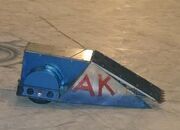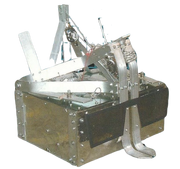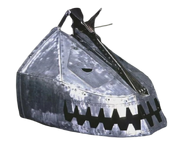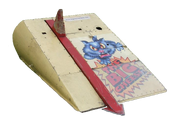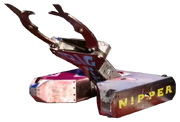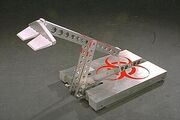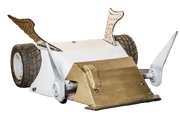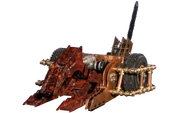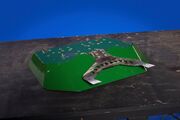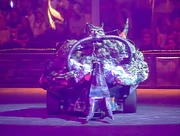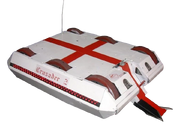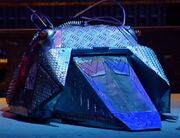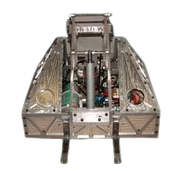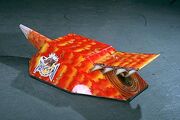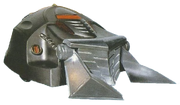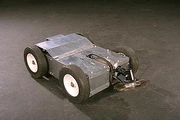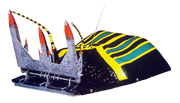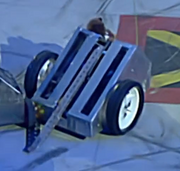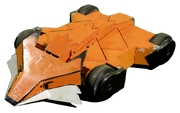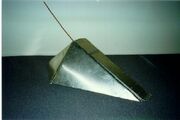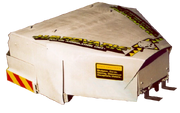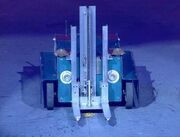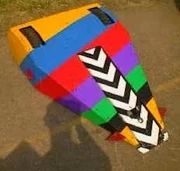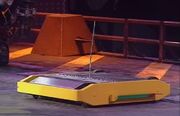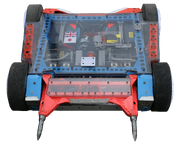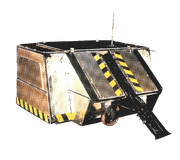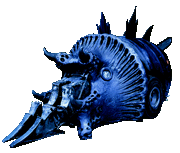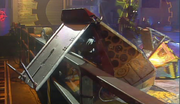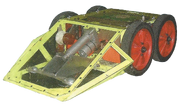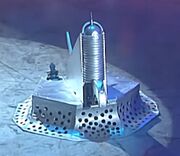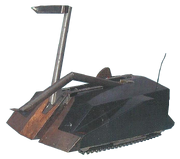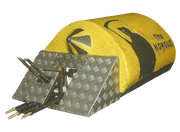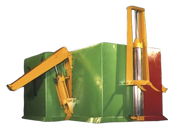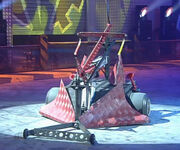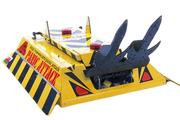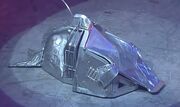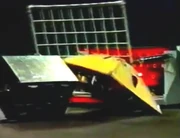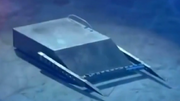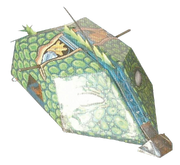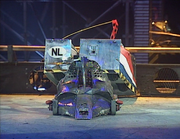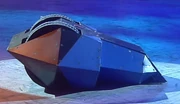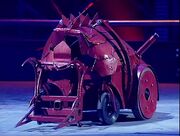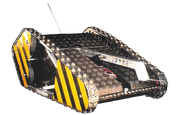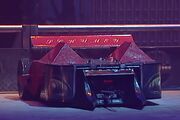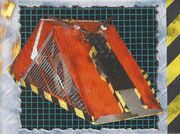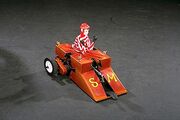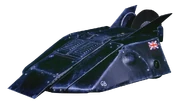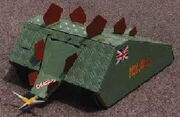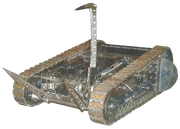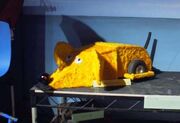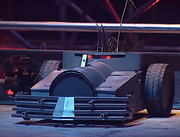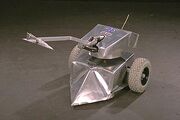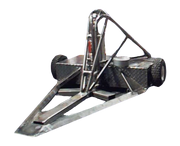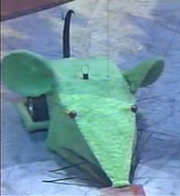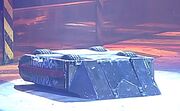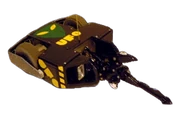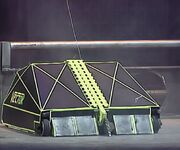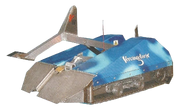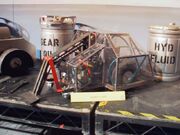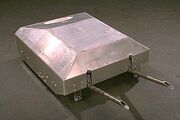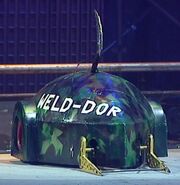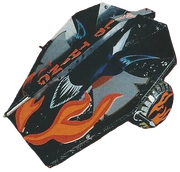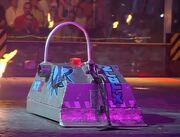Lifters are a common and wide-raging type of lifting weapon found in Robot Wars. The first robot to be equipped with such a weapon was Shogun in Series 1, with the most notable lifter-wielding robots including Series 2 champion Panic Attack, Third World Champion Storm 2 and US Season 1 champion Panzer Mk 2.
Definition[]
- A lifter is not restricted to one specific shape or size, most commonly existing in the form of arms, forks, spikes, or even large plates resembling those of front- or rear-hinged flippers. They can be operated using a variety of mechanisms including, but not limited to, electric, pneumatic, hydraulic or spring-based systems.
- Lifters are designed primarily to lift opponents partially or completely off the ground, before turning them over or suspending them while the robot carries them around the arena. The main distinction between lifters and flippers is that during the attack, robots remain on the lifter until it is released, falls off, or is successfully rolled onto its side or back. This contrasts greatly with flippers, which aim to launch other robots into the air and allow gravity and torque to flip the robot over or out of the arena.
- Certain lifters, such as those used by Eric and Panzer Mk 2, were nevertheless powerful enough to turn opponents over instantly, somewhat blurring the above distinction.
- A lifter equipped with a clamp(s) so that it can grab and lift at the same time is called a grappler.
Advantages and Disadvantages[]
Advantages
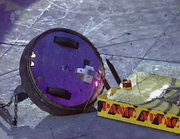
Panic Attack topples Whirling Dervish onto its back in Series 2

King B Powerworks stabs Tornado with its forks during its Extreme 1 Mayhem battle

The Big Cheese hoists Shrapnel over the pit
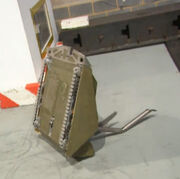
Mortis demonstrates its self-righting arm
- Lifters were especially effective weapons in early series, being able to overturn robots and immobilise them instantly before the invention of the srimech. Panic Attack's runs in Series 2-4 are perhaps the best examples of this.
- Lifting weapons usually had sharp ends, allowing them to double as ramming spears, spikes, or blades. King Buxton was consistently able to use its forks to jab and pierce through its opponents in its appearances, as did Dreadnaut during its Series 3 victory over Psychokiller.
- Lifters could easily be incorporated into invertible robots. King Buxton, Suicidal Tendencies, Storm 2, Big Nipper, and S.M.I.D.S.Y. are among the most notable examples.
- They could act as effective pitting weapons, with robots such as Panic Attack, The Big Cheese, and S.M.I.D.S.Y. all using their lifters to carry and lower their opponents into the pit with considerable success.
- Lifters could offer a useful weapon synergy when combined with another weapon type, especially axes. It was not uncommon for lifting arms to be placed side-by-side with axes or hammers, with Mortis, Vercingetorix, and Comengetorix all featuring this synergy. Big Nipper was also notable for combining its lifter with a set of crushing claws.
- Some lifters were capable of doubling as clamps, such as the lifting arms of The Big Cheese, Foxic, and the Series 4 version of Wild Thing.
- From Series 3 onwards, they could be designed in such a way as to act as the robot's self-righting mechanism, reducing the need for a separate mechanism to be added. Mortis' arm was capable of righting itself whenever it was flipped, while other lifting weapons such as Probophobia's forks were capable of rotating a full 360-degrees.
- Lifters - especially in later series - could easily be incorporated into designs featuring interchangeable weapons. These can either take the form of a standalone weapon which could be exchanged for another (e.g. Big Nipper and Storm 2's arms in the reboot) or a single weapon with multiple configurations to suit different opponents (e.g. the various wedge, scoop and fork-type lifter ends designed for Foxic).
Disadvantages

After losing power during its Heat Final against Chaos 2, The Big Cheese's lifter was unable to act as a srimech
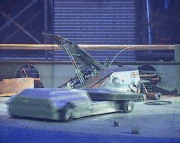
Stealth's lifter mechanism is severed by Hypno-Disc
- With the above exceptions, most lifters were not usually large or powerful enough to self-right. The Big Cheese's defeat to Chaos 2 in Series 3 was attributed to its lifting arm losing half of its power during their Heat Final, which prevented it from being able to lift itself back onto its wheels. Meanwhile, other robots such as Panic Attack required separate self-righting mechanisms which cost them in weight and/or weapon power. As shown by Panic Attack's various losses to Firestorm however, those self-righting mechanisms were not always effective or reliable either.
- Lifters were often slower than flipping weapons, which meant that they were not able to be used effectively if opponents moved quickly enough. This setback was especially crucial in the decline of Panic Attack in later series, which, whilst able to eliminate Edge Hog and Spin Doctor, was overpowered by Kronic 2, Terrorhurtz, Tough as Nails and Dantomkia in Series 6-7.
- Often the weapons or their mechanics could be vulnerable to damage, perhaps more so than flippers. For example, Panic Attack's forks were easily susceptible to damage, as its encounters with Mortis, The Steel Avenger, Barber-Ous, Pussycat, and Tough as Nails demonstrated. Meanwhile Stealth's entire pneumatic mechanism - akin to that of earlier rear-hinged flippers - was destroyed by Hypno-Disc after its 'ram' was left open.
List of Robots with Lifters[]
Robots are listed alphabetically.
DESKTOP MODE ONLY: Robots which are not heavyweight entries are listed with a green background. House Robots are listed with a gold background. Robots from the original 1994-1997 US competitions are listed with a purple background.
| Robot | Series Appearances with Lifters | Notes | Image |
|---|---|---|---|
| A-Kill | Series 6 | Lifter was "powerful enough to lift the skin off a rice pudding", according to the team. | |
| Armadillo | Series 2 | Featherweight Championship only; articulated rear 'tail'. | |
| √3² | Dutch Series 2 | Three-part clusterbot, although only two segments featured lifting or flipping weapons. S.O.Xbot featured a linear actuator-powered lifting arm, while Elevation featured a larger pneumatic-powered flipping arm; the latter was only able to lift heavyweight opponents due to its small size. | |
| Aggrobot | Series 6-7, Extreme 1 | A small bar at the bottom of Aggrobot's wedge would push down on the ground, lifting the wedge. | |
| Ansgar's Revenge | Series 6, German Series | ||
| Arena Killer | Dutch Series 1, German Series | Competed as Arena Killer in Dutch Series 1, and Absolut Krankhaft in the German series. | |
| Arnold, Arnold Terminegger | Series 4, Extreme 1 | Front forklift-style lifter powered by a 400W winch motor. Lifting capacity of 140kg. In Extreme 1, the forklift was combined with an overhead axe weapon, with a scissor-like motion. | |
| Beast of Bodmin | Series 3 | Small front 'flipping ram' mounted at the tip of its wedge. | |
| Berserk 2 | Series 3-4 | A set of rear forks mounted on a larger arm. Series 3 Heat-Finalist. | |
| The Big Cheese | Series 3 | A large red lifting arm powered by a linear actuator. Capable of leaving other robots dangling in the air - even Sgt. Bash - and acting as a clamp. | |
| Big Nipper | Series 5, 7-8, 10 | Combined with a set of horizontal crushing claws to make a grappler. Series 5 version was a simple front-mounted lifter, which was redesigned from Series 7 onwards into a centrally-mounted arm enabling Big Nipper to self-right. Lifting capacity of 200kg in Series 7 and 300kg in Series 8. Interchangeable with another arm featuring a vertical flywheel in Series 8 and 10. | |
| BioHazard | 1996-1997 US Championships | Four-bar electric lifting arm with twin spring-loaded front plates - the first combat robot equipped with such a weapon. First robot documented to self-right with a powered weapon, doing so in 1996. 1996 and 1997 US Robot Wars Heavyweight Face-Off Champion; 1997 Heavyweight Melee Co-Champion. | |
| Centurion | Series 3 | Replaced with a flipper in Series 4. | |
| Cherub | Series 9 | Cherub's two lifting forks turn 360 degrees, and can allow Cherub to handstand, and lift other robots. | |
| Comengetorix | Series 5-6, Extreme 1 | Lifting arm paired with a pneumatic axe. Successor to Vercingetorix which previously used this pair of weapons. | |
| Coyote | Series 9-10 | Featured two lifters which worked in conjunction with a vertical clamp to grip and lift, making it a grappler. | |
| Crackers 'n' Smash | Series 9-10 | Crackers originally featured a front-hinged lifting arm, which was replaced by a set of interchangeable rear-hinged lifters in Series 10. | |
| The Creature | Series 4 | Set of aluminium lifting tusks resembling those of Matilda. Tusks were electrically-operated. | |
| Crusader | Series 3-4 | ||
| Deadline | Series 2 | Featherweight four-bar lifter built by Team Terrafonics. Omitted from the televised broadcast. | |
| Depoppesaurus Rex | Series 3 | Predecessor to the more successful Philipper machines. First Belgian competitor in Robot Wars. | |
| Derek! | Series 5 | Added apparatus to help the lifter be used as a srimech. Used a vertical spinning disc in Series 6. | |
| Diotoir | Extreme 2 | Equipped with a spring-loaded flipping weapon in previous appearances, but for Extreme 2, the weapon was in the form of a small lifting plate. | |
| Draggon Waggin' | 1996 US Championship | Pneumatic 'articulated jaw' functioned similarly to a lifter, though potential lifting capabilities were never addressed by the team. Erroneously referenced as Dragon Wagon in American Robot Wars 1996. | |
| Dragon | Extreme 2 | Featherweight Championship. | |
| Dreadnaut | Series 1-4 | Small lifting prongs replaced with hardened steel forks from Series 2 onwards. Final incarnation, named Dreadnaut XP1, used an upgraded weapon system powered by motorcycle starter motors. | |
| Dynamite | Series 6 | Loanerbot, representing Germany in the UK vs Germany Special. | |
| Elvis | Series 2 | ||
| The Enforcer | 1996 US Championship | A lifting arm with a sawblade attachment which can be interchanged. | |
| Enzyme | Series 2 | ||
| Eric | Series 3-4 | Hydraulically-operated 'lifting jaw', functioning both as a conventional lifting arm and a clamp weapon. Lifting capacity of 200kg. | |
| Evil Weevil | Series 3-4 | Series 3 Semi-Finalist and Robotic Soccer champion. A set of three lifting forks, later two in Series 4. Combined with a pneumatic hammer in Series 4. | |
| Falcon | US Season 1-2 | Initially interchangeable with an axe-like 'spike' weapon, became the robot's main weapon in US Season 2 with a slower mechanism. US Season 2 Grand Finalist as The Falcon Mark 2. | |
| Flipper | 1996 US Championship | Lightweight. Pneumatic rear-hinged lifting panel powered by airbrush propellant. 1996 Lightweight Melee finalist.[1] | |
| Flybot | Extreme 2 | Featherweight built by future Robot Wars champions Team MAD. | |
| Forklift | Series 2 | First 'forklift' style lifter robot. | |
| Foxic | Series 8-9 | Doubles as a guillotine clamp. Featured interchangeable lifting arm and plate in Series 8. Series 9 version featured a lifting arm with interchangeable wedges and hooks, including an anti-spinner wedge. | |
| Gator | 1996 US Championship | Lightweight. Front lifting arm utilising a custom rail, rod and sprocket mechanism. Intended to hold opponents off the arena floor for knockout 'pins'.[2] | |
| General Carnage | Series 3 | Featured a claw on the end of the lifting arm. | |
| Griffon | Series 2-3 | Four-bar lifting arm powered by linear actuators, inspired by BioHazard. Series 3 iteration featured an upgraded weapon with a lifting capacity of 300kg. Series 2 Internet Insurrection winner; during the same battle, Griffon also became the first robot to turn Sergeant Bash over. | |
| Guzunderbot | Series 5 | ||
| Haardvark | Series 2-3 | Set of forks powered by a motorcycle starter motor, reprofiled and made out of hardened steel for Series 3. Series 2 Semi-Finalist. | |
| Havoc | Series 2 | Interchangeable with a mace and a battering ram. | |
| Hellbent | Series 7 | Pneumatic lifting forks, capable of flipping opponents completely over. Used in tandem with a pneumatic axe. | |
| HIGH-5 | Series 9 | Interlocking lifting/clamping jaws shaped like a pair of hands. Lifting capacity of 280kg. | |
| Immortalis | Series 5 | Pneumatic plough-shaped lifter with three sides. | |
| Indefatigable | Series 4 | Spiked forklift, with a lifting capacity of 75kg. | |
| Inquisitor Mk 2 | Series 3 | Only competed in the Series 3 Pinball Competition, but was able to overturn Matilda. | |
| Inverterbrat | Series 3-4 | Pneumatic lifter consisting of two arms which could separate while lifting opponents. Lifting capacity of 100kg. | |
| Judge Shred | Series 3 | Pair of lifting arms featuring sets of pincers on the end. | |
| Kick Robut | Series 2 | Super Heavyweight Champion. Most powerful lifter. Pair of rotating lifting spikes mounted either side of the robot's chassis. | |
| King Buxton | Series 2-5, 7-8, Extreme 1 | Pair of electrically-operated lifting forks. Series 2 Semi-Finalist and Series 4 Tag Team Terror champion alongside 101. Relied more on its pushing power than the forks. | |
| Kater Killer | Series 4 | ||
| Mace | Series 2-3 | Used an electric lifting arm in Series 2. Was converted to a pneumatic lifting arm for its return in Series 3 as Mace 2. Two-time series semi-finalist. | |
| Major Tom | Series 4 | Featured a lifting plate, replaced by a flywheel weapon in later series. | |
| Manic Mutant | Series 3 | ||
| Mantis | Series 7 | Lifter acted as grappler with crushing claw. | 
|
| Matilda | Series 1-7, Extreme 1-2, US Seasons 1-2, Nickelodeon, Dutch Series 1-2, German Series | Pair of pneumatic tusks lifting from within the front bodyshell. Upgraded in Series 4 and as part of her Extreme 1/Series 5 rebuild. Series 8-10 build converted the tusk design into a more powerful flipper assembly. | |
| Maximus | Extreme 2 | Front-hinged lifter described as a 'flipper'. Featured a circular saw protruding through the lifter plate. | |
| Medusa 2000 | Series 4 | The lifting plate was mounted on the bottom part of the wedge, raising the front of the robot off the ground when opened. | |
| Metalis | Series 7 | A 'full-body lifter', incorporating a three-sided lifting plough and a crushing claw. Base was spread around the perimeter of the machine, excluding the rear. | |
| Millennium Bug | Series 4 | A walkerbot. | |
| Mortis | Series 3-4 | First competitor robot to combine an axe with a lifting arm, used in tandem with its famous 'tantō blade'. Arm could act as a srimech. Series 4 War of Independence champion. | |
| The Morgue | Series 4-5 | The Morgue in Series 4 had front lifting forks powered by a linear actuator, based on a 'shunt-and-lifting' system. Capable of lifting 150kg. Later versions generally used a variety of pneumatic lifting and flipping weapons, though Mini Morg would use lifting forks in Series 5. | |
| The Mule | Series 2 | CO2-powered forklift with a lifting capacity of 150kg, used in tandem with three pneumatic 'bucking legs' on the sides and rear. Winner of the Best Engineered Robot award in Series 2. | |
| Namreko 3000 | 1996 US Championship | Grabbing/lifting jaws powered by 'lead-screw linear actuators'.[3] | |
| NEATer Machine | Series 7, Dutch Series 2 | An A-shaped scoop-type lifter, converted from a static weapon first used by the robot's Dutch Series 2 incarnation, Neater. Lifting capacity of 100kg. | |
| Panic Attack | Series 2-7, Extreme 1-2 | Pair of lifting forks operated by linear actuators. Series 2 Grand Champion and multiple Semi-Finalist in subsequent series. Came closest to lifting an opponent out of the arena. | |
| Philipper | Extreme 1, Dutch Series 1 | Utilised two lifters, at the front and rear. Instead used a flipper and crusher when competing as Philipper 2. | |
| Phoenix | Series 7 | Middleweight. | |
| Pika 3 | Dutch Series 2 | ||
| Pokey | 1996-1997 US Championships | Middleweight. Front-mounted CO2-powered forklift. Lifting capacity of 'about 250lbs'.[4] 1997 Middleweight Face-Off Semi-Finalist. | |
| The Predator | Series 4 | Front-mounted forklift. | |
| Probophobia | US Season 2, Nickelodeon | Pair of lifting prongs which could rotate 360 degrees and act as a srimech. | |
| Raizer Blade | Series 3-4 | Four-bar lifting arm, operating at 2,400psi and powered by a Ford Granada-sourced AVS pump. | |
| Rampage 2 | Series 7 | Featherweight Championship finalist. | |
| Razer | UK Series 2-6, 8, Extreme 1-2, US Season 1-2 |
Crusher 'tail' doubled as a lifter on very rare occasions. Front claw/hook attachments used similarly against Tornado's 'anti-crusher weapon' in Series 6 and Extreme 2. | |
| Reaper NP2 | The Third World Championship | ||
| Red Dragon | Series 3 | ||
| Robo Doc | Series 2 | ||
| Robopig | Series 3 | A hinged spike mounted within the robot's 'snout', referred to as a 'Vicious Piggy Lick'. Weapon could alternately be used for lifting and bludgeoning opponents. | |
| Rohog | Series 5 | ||
| Schumey Too | Series 3 | Pneumatic front lifting forks. | |
| Serpant | Extreme 2 | Antweight; worked in conjunction with a grabbing claw, making it a grappler. | |
| Shadow of Napalm | Series 4 | ||
| Shogun | Series 1 | First robot with a lifter in the UK Series. | |
| S.M.I.D.S.Y. | Series 3-7, Extreme 1-2 | Earlier versions of the robot featured a set of jaws which could also double as lifting wedges. Top jaw was remodelled into a scoop-type lifter for Series 6 and Extreme 2, featuring a set of four spikes at the base. The lifter was redesigned again for Series 7, which also saw the lower jaw removed altogether. | |
| Spunkey Munkey | 1996 US Championship | ||
| Stealth | Series 3 | Slow-actuating pneumatic "lifting ram", which had its rams famously sliced apart by Hypno-Disc. Referred to as a 'flipper' or 'flipper device' by Philippa Forrester. | |
| Steg-O-Saw-Us | Series 3 | Series 3 Grand Finalist, but the lifting tail was almost never used. | |
| Storm 2 | Series 7-8 | Added a four-bar lifter for Series 7 in order to comply with the active weapons rule. Series 7 runner-up and Third World Champion, though relied on its speed and pushing power as its primary weapon. Made interchangeable with a front-hinged flipping arm and a vertical flywheel for Series 8. | |
| Suicidal Tendencies | Series 4 | Series 4's Suicidal Tendencies used a pair of titanium lifting spikes, used in tandem with a 'toothpick' axe. Used a lifting scoop in Series 5. | |
| Sumpthing | Series 4, 6, Extreme 2 | ||
| Squirmin Vermin | Nickelodeon | Competed in US Season 1 as The Green Mouse. | |
| T 2 | Series 3 | Modelled on a steam locomotive cowcatcher, claimed to have a lifting capacity of 182 or 300lbs. | |
| Tazz | 1996-1997 US Championships | Electric lifting/thwacking arm connected to a 360-degree turret. Renamed Tazbot for 1997; two-time Heavyweight Face-Off Quarter-Finalist. | |
| Terror-Bull | Series 4, 6 | ||
| Tetanus | Series 5-6, Extreme 2 | The original version used a single lifting spike, which was used in tandem with a set of four static claws to simultaneously lift, clamp and crush opponents, making it a grappler. Tetanus 2 initially used a set of forks with a top-mounted crushing arm; for Extreme 2, it was equipped with a third lifting fork, attached to a rollcage-style self-righting mechanism. | |
| Technophobic | Series 3 | Armed hydraulic lifting arm. | |
| Texas Tornado | US Season 2 | ||
| The Gap | US Season 2 | Described by the show as a 'pneumatic lifting platform'. | |
| The Green House | US Season 1 | Later converted into Vert-I-Go. | |
| The Green Mouse | US Season 1 | Later converted into Squirmin Vermin. | |
| The Steel Avenger | Series 5, 7, Extreme 1-2 | Rear weapon added after the 100kg weight limit was introduced, to compliment its primary bladed axe. | |
| The X-2 | 1996 US Championship | Featherweight. Fast-actuating pneumatic forklift, capable of flipping opponents in its weight class over with ease. 1996 Featherweight Melee Champion and Face-Off Quarter-Finalist.[5] | |
| Tornado | Series 7 | Part of its interchangeable weapons system. Used in one fight only, during its Heat Final against Tetanus Booster. | |
| Tridentate | Series 6 | Set of three small rotating spikes, two of them of which are able to rotate a full 360 degrees. | |
| UFO | Series 6 | Later used a front-hinged flipper in Series 7. | |
| Vector | Series 3 | Said to double as piercing arm and srimech. | |
| Vercingetorix | Series 2-4 | Purely a lifter in Series 2 and 3, later paired with a spiked axe in a similar configuration to Mortis for Series 4. | |
| Vert-I-Go | Nickelodeon | Converted from The Green House. | |
| Vlad the Impaler | 1996-1997 US Championships | Twin pneumatic lifting forks which could also be used a ramming spears. | |
| Weld-Dor | Series 3 | Front lifting forks with a lifting capacity of 90kg. | |
| Wild Thing | Series 4-5, Extreme 1 | A lifting lance capable of acting as a clamp and a self-righting mechanism. Combined with a horizontal spinning disc in Series 5/Extreme 1. | |
| X-Terminator 2 | Series 4 | Interchangeable with the robot's signature axe, but proved the more effective weapon in battle, reaching the Semi-Finals of Series 4 with this weapon. Later replicated as the robot's weapon of choice in its minibot. |
[]
| ||||||||||||||||||||||||||||||||






